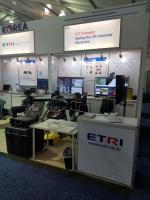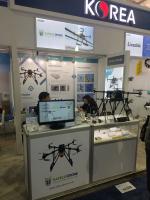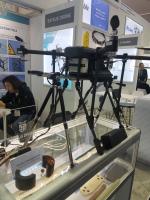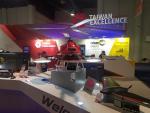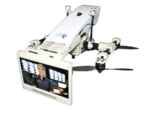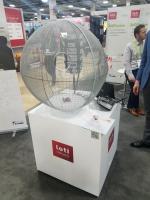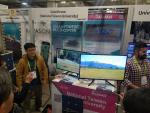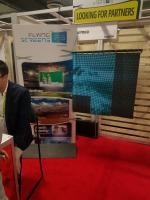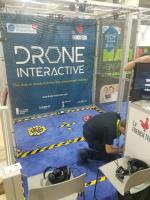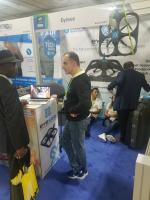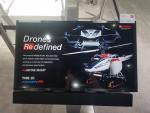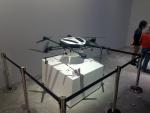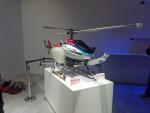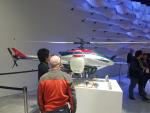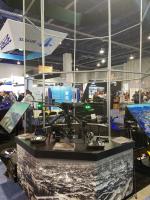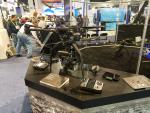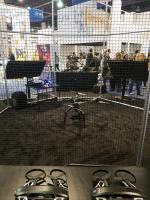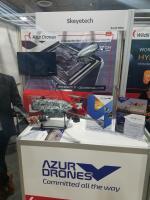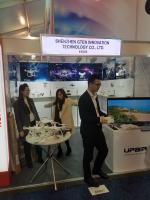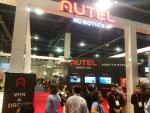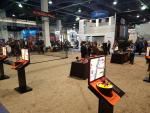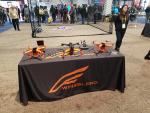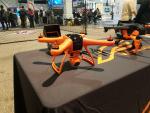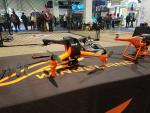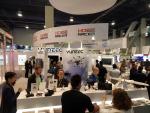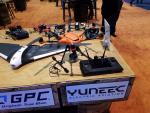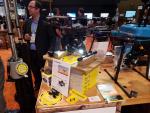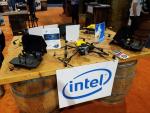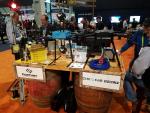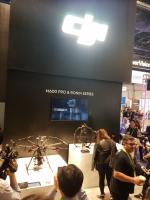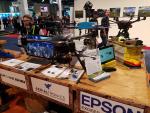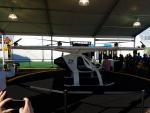At CES there were lots of UAVs (Unmanned Aerial Vehicles), also known as drones or Remotely Piloted Aircraft (RPA). However, I didn’t see any AAVs (Autonomous Aerial Vehicles). Two key areas that will require further technology development are: longer-life batteries and autonomy systems.
ETRI (Electronics and Telecommunications Research Institute)
They were showing a huge x8 multi-rotor platform designed for remote-sensing applications.
Volt Spider by Safeus Drone
They were showing a prototype of their UAV for inspection of high-voltage power transmission lines.
Apparently it can land on the cable and grasp it. It also has inductive charging.
Website: www.safeusdrone.com
CX-180 Reveal ONE by TTRobotix (Thunder Technology Co. Ltd)
An unmanned, electrically-powered helicopter with a payload for thermal imaging and detecting human vital signs.
Website: www.ttrobotix.com
SurV by Radii Robotics
This is advertised as an indoor, autonomous security drone.
What’s interesting is that it looks like a UAV with a big TV screen.
Website: www.radiirobotics.com
|
Fig. 6:
|
360Fusion by Leti (CEA Tech)
This research institute was demonstrating their anti-collision software for drones, by flying a little micro UAV inside a dome.
It looks like the small drone has 6 proximity sensors facing in 6 different directions.
|
Video:
Interview and demo. |
SolarDrone by National Taiwan University
They were showing videos of their solar-powered quadcopter.
Website: ntu.edu.tw/~lincf/
Flying Screen by Arquimea
They have developed a light-weight, LED based screen that can be used outdoors and potentially attached below a drone.
At their booth they showed a screen consisting of 3 vertical sections, hung side-by-side.
Website: www.arquimea.com
Another company, NTT Docomo recently announced they have developed a spherical flying screen:
www.nttdocomo.co.jp/media_center/pr/2017/0425_00.html
Drone Interactive
They are developing drone-based, interactive games for amusement centers.
Website: www.drone-interactive.com
Eyesee
Apparently this is the “first autonomous drone for warehouses”.
It reminds me of the Parrot drone, but it’s designed for inventory checking in warehouses.
Website: www.eyesee-drone.com
Yamaha
They were showing two UAVs designed for industrial or agricultural purposes.
The “YMR-01” is electrical and has 8 rotors. It’s design is something between a hexacopter and an x6.
The “FAZER R” is a gasoline (petrol) powered helicopter.
D-02 by XDynamics
They were demonstrating their D-02 x8 multi-rotor, designed for professional cinematography or industrial purposes.
Website: www.xdynamics.com
Skeyetech – Azure Drones
They had on display a quadcopter painted in camouflage, designed for surveillance purposes.
Website: www.azurdrones.com/en/
UpAir by SGI (Shenzhen Gten Innovation) Technology Co. Ltd
SGI were showing their UpAir photography drone, which looks quite similar to DJI’s Phantom drone.
Website: www.upairdrone.com
The following website has a comparison between the SGI UpAir and DJI Phantom:
www.halfchrome.com/upair-one/
Autel Robotics
An orange-colored photography drone that looks similar to the DJI Phantom.
Website: www.autelrobotics.com
Wingsland (Shenzhen Wingsland Technology Co. Ltd)
This company sells various orange-colored drones. Their “Minivet” is similar to the DJI Phantom.
Yuneec
The “H520” is an orange-colored drone for industrial purposes.
The “Typhoon H Plus” is a hexacopter designed for professional photography. They had a custom Typhoon fitted with some “Rugo” spotlights, by Foxfury Lighting Solutions (Fig. 28).
Website: us.yuneec.com
Falcon 8+ by Intel
This octocopter has a no-nonsense design with the rotors arranged in two rows. It can carry imaging payloads like a full-size SLR camera.
Website: www.intel.com/products/drones/falcon-8.html
Hercules 10 by DroneVolt
This company has various products, such as a tethered quadcopter for surveillance.
The “Hercules 10” is a x8 multi-rotor with a high-pressure sprayer for agricultural purposes.
Website: www.dronevolt.com/en/
|
Fig. 30: |
DJI (Da-Jiang Innovations Science and Technology Co. Ltd)
One of the most well-known companies in low-cost drones.
Website: www.dji.com
AerialTronics
Their “Altura Zenith” is a x8 multi-rotor designed for industrial inspection.
The “Pensar” imaging payload combines a Sony HD camera with 30x zoom, FLIR Boson thermal camera, NVidia Jetson GPU, OCR (Optical Character Recognition) and object recognition using deep learning.
Website: www.aerialtronics.com/en/
Volocopter
They are working on an electric multi-rotor designed as a personal transportation device.
So far they have demonstrated vertical take-off and hover (with human passenger), and a pilot-less takeoff and short flight.
Website: www.volocopter.com/en/
